Do you have any
Which DEFIB?
AED’s, DEFIBS, PAD units, Joules, IP ratings? Is it any wonder that choosing your defibrillator can be really confusing when sales staff talk of “essential” attributes you should be looking for. At AED-DEFIB-SHOP we will talk to you in plain english, explaining what you need to know, and let you choose the best unit for you (they’re not all the same). We’ll advise you on the unit that best suits your workplace environment, and not just sell you the one we have the biggest stock of. Phone us on 0800 0431 327 for a chat, we know you’ll be pleasantly surprised.
We’ll spend a bit of time on the phone finding out what are your concerns about purchasing one of these potentially life-saving devices, and what environment it will be used in, who will be using it (we’ve installed defibrillators with scout troops) and even advise on maintenance and servicing.
We want you to not only be delighted with your purchase, but to tell others about how well you were treated, and that makes us happy. Our Managing Director (Duncan) is a qualified NHS trained general nurse, with extensive experience in both a Coronary Care and Intensive care environment, so knows what customers are looking for.

We supply defibrillators to all types of businesses, from small businesses and shopping centres, to dental surgeries and major distilleries. And it doesn’t stop at supplying units, we’re there for the day to day advice, and supplying of replacement electrode pads and batteries, post cardiac arrest and on expiry of existing consumables for your unit. We’re here for the long haul, not just to shift boxes.
Give us a call. We know you’ll be impressed.
So we have answered some of the most common questions we get asked on a regular basis for you. Don’t worry if you can’t find the answer to your questions, you can give us a call on 0800 0431 327 and one of our experts will happily answer any queries you may have.
Alternatively you can use the contact us button below to submit a question online.
Book Now Contact us Cart ( 0 Items )
Cart ( 0 Items )
 p
p




